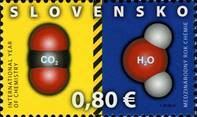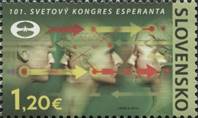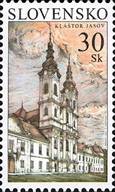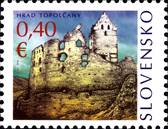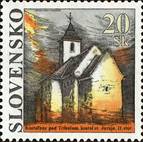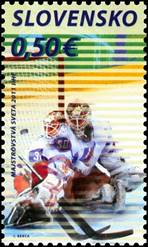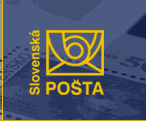P=have O=don’t have it
See:
Czechoslovakia
and Czech
Republic
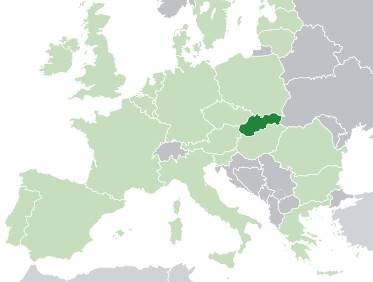

Scott: #70-3P
Issued: 23.5.1942
National Philatelic Exhibition
Inside #70-3: Stamp Collecting
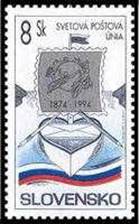
Scott: #188P
Issued: 1.8.1994
120th Anniversary UPU
Inside #188: Pseudo Stamp
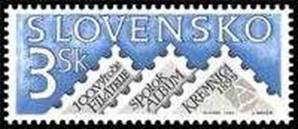
Scott: #217P
Issued: 1.6.1995
Dunafila
'95
Inside #217: Pseudo Stamps

Scott: #217aO
On
March 30th 1895 Aurel and Klement Lehotzky founded a
"stamp club" in the home in Kremnica of
their grandfather, the Slovak patriot, historian and city archivist Pavol Križko. Later given
the name Album, its aim was "to collect postage stamps and save them from
oblivion".
The
Album club, the first Slovak philatelic organisation,
laid the foundations - at the turn of the century - of organised
philately in
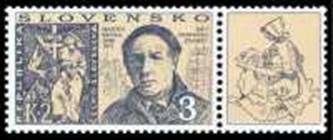
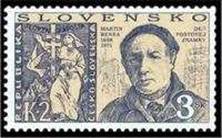
Scott: #262P
Issued: 18.12.1996
Stamp Day
 Inside
#262: Essay - Unissued 1938 Stamp
Inside
#262: Essay - Unissued 1938 Stamp
The
painter and illustrator, National Artist Martin Benka
(1888-1971) was one of the most important figures in the founding generation of
modern Slovak art, a generation which presented the life and myth of the native
land. Benka's work emphasised
the link with traditions and folk culture. He possessed a distinct style and
succeeded in creating an oeuvre that was essentially Slovak - an epic celebrating
his native land, its nature and its people. His mode of expression was unique,
with emphasis being placed on decoration drawn from the folk art, customs and
music that were the source of his inspiration and exploration. He was one of
the first artists to draw recognition for Slovak art abroad. Alongside his
substantial achievement in painting, Benka also
undertook work of an applied character. Between 1936 and 1940 he devoted much
effort to designing for postage stamps, dominant motifs being the people and
their environment, the birth of the "
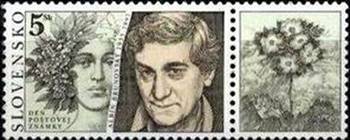
Scott: #346P
Issued: 18.12.1999
Stamp Day, Albin Brunovsky, stamp designer
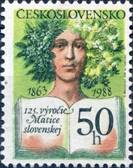 Inside
#346:
Inside
#346:
Design component: motif detail only in monotone
Thanks to Lou Guadagno
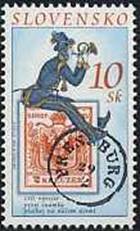
Scott: #357P
Issued: 1.6.2000
150th Anniversary, First Stamp Used in
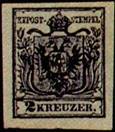 Inside
#357:
Inside
#357:
It
has been already 150 years since the first postage stamps, valid on the
The
motive of the first issue of the botage stamps valid
on the Slovak territory was the Emperor's crown and on both of its sides there
was the inscription "K. K. POST - STEMPEL". In the lower part of the
stamps there is a label with the value data. The first printed issue contained
5 postage stamps with the nominal values 1, 2, 3, 6 and 9 KREUZER (local
currency). The postage stamps do not bear the name of the country, their
identification mark is the Habsburg Emperor's and King's crown.
After
the Austrian-Hungarian split in 1867 the Hungarian postal service wanted to
publish its own postage stamps, but it was then not technically ready for
printing. Therefore the new issue of 1867 was printed by the Austrian
authorities and the postage stamps were valid in both parts of the monarchy.
The first stamps printed in
The
first Czecho-Slovak stamps were printed on the 18th
December 1918, when the title "
The
first Slovak stamps were published on the 1st January 1993, which is
the date of establishement of the Slovak republic. http://www.pofis.sk/
********
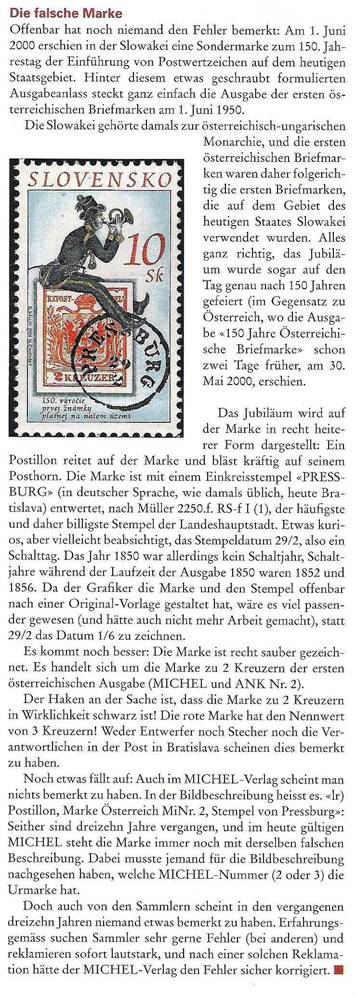
Martin
Hirschbühl Wrote: This article was part of our latest SBZ issue (Swiss
stamp Journal). This Slovensko stamp was issued to
celebrate the first Austrian stamp of 1850. It mentions the fact, that the
shown 2 Kreuzer stamp of
The
next possible 29th February was in 1852. A classical “double fault”.
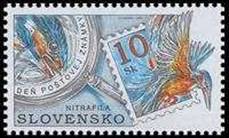
Scott: #419P
Issued: 18.2.2002
Stamp Day / Nitrafila
Inside #419:

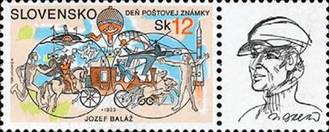
Scott: #446P
Issued: 28.11.2003
Stamp Day 2003
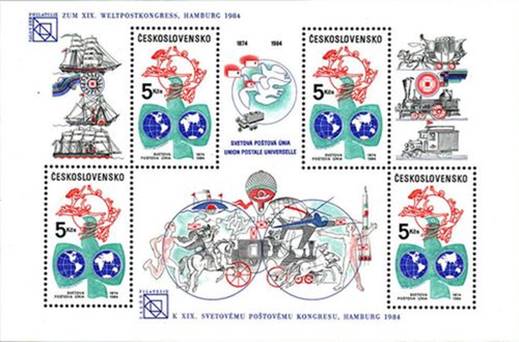
Inside #446:
The stamp honors Slovak stamp designer, Jozef Balaz (1923-2006), whose
self portrait is on the label
http://www.unostamps.nl/person_balaz.htm
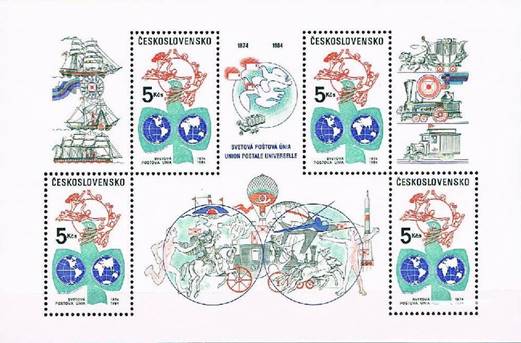
Inside #446: Czechoslovakia #2517 s/s margin
detail—re-colored without UPU inscriptionsP (Czechoslovakia)
Lou
wrote: I found that there are two different sheetlets
noted for the issue, with big differences in cost. The first sheetlet has additional inscriptions in the top and bottom
margins noting the UPU World Postal Congress in Hamburg, and sells for up to $
30.00; the other sheetlet without the inscriptions
just notes the UPU, and sells for $ 3-4.00. The same SOS design component is on
both sheetlets, so there is no need to buy the more
expensive one.
Thanks to Lou Guadagno
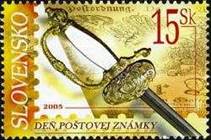
Scott: #491O
Issued: 25.11.2005
Stamp Day
Inside #491: Pseudo Stamp
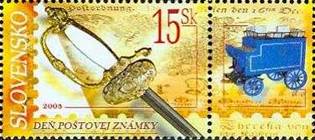
All
employees in the service of post offices wore a uniform. Higher officers and
postmasters wore especially beautiful and richly decorated "gala"
liveries made of high-quality cloth. The design of the uniforms for officers
and other employees of post offices is described in detail in Decree of Vienna
Court Chamber, dated 1815. According to this Decree a
gold-plated cord was worn with the uniform.
The
preserved uniform, as well as accessories, such as the prerequisite trumpet,
and the models of means of transport used for postal services in the past are
only several of the precious collections of the
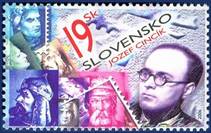
Scott: #511P
Issued: 24.11.2006
Day of the Postage Stamp - Jozef Cincík

Inside #511: Slovakia #95O,
#96P,
#97P,
#98O, #99P,
#100O, #101O,
#102O
Jozef Cincík
– a visual artist, illustrator, graphic designer, art historian, stage
designer, editor, and university professor - was born on March 8, 1909 at his
parents’ adopted abode of
After
1932 he worked at the Matica slovenská
as an officer and later as secretary of the Artistic Division, also managing
the State Office for the Protection of Historical Monuments for Central
Slovakia, and simultaneously studying philosophy and art history at
Apart
from Jozef Cincík's
portrait, the stamp contains motifs based on his stamps Kniežatá
(Princes, 1944) and on the FDC based on the stamp Poštový
kongres (Post Congress, 1942).
The
details come from the Slovak National Library (Martin) archive and book
collection. Magdaléna Brincková.
http://www.pofis.sk/
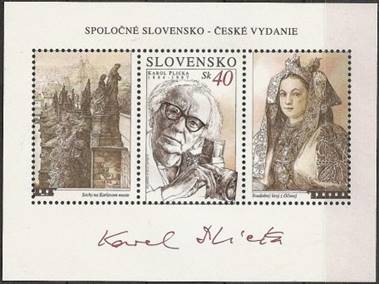
Scott: #548O
Issued: 12.9.2008
KAREL PLICKA (1894-1987)
Issued jointly with Czech Republic
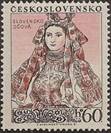 Inside #548 (Right Label): Similar to
Czechoslovakia #707P (Czech Republic)
Inside #548 (Right Label): Similar to
Czechoslovakia #707P (Czech Republic)
Karol
Plicka was the key Slovak cultural personality of the
first half of the twentieth century. The founder of cinematography and a
pioneer of photography, he was among the first Slovak photographers to base his
work on a clearly formulated conception.
Born
in 1894 to Czech parents in
Plicka
anticipated the imminent dissipation of the spiritual and aesthetical values of
traditional folk culture. This prompted him to put immense and consistent
effort into their recording, not only by writing and photographing, but also –
in so far as the technology of his day allowed through gramophone recording and
film-making. The result was his synthetic opus Zem spieva (The Earth Sings, 1932 – 1933), the first sound-film
in the history of
It
seems that, at least initially, Plicka’s experience
with the almost ‘pre-historic’ religiosity and poverty of Slovak people moved
him to take a strictly and purely documentaristic
approach to his work. However, it was later in the 1930s that the monumental
nature of his photographs - somewhat similar to the paintings of Martin Benka - prevailed and Plicka
managed to enhance his works further by a strong poetical setting. These are
the photographs that were later used in the photo-book Slovensko
(
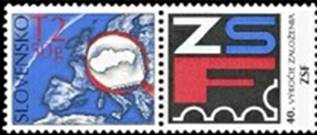
Scott: #573P
Issued: 29.4.2009
40th Anniversary of the foundation of the Union of Slovak
Philatelists (ZSF)
Inside #573: Pseudo Stamp
Thanks to G.B.
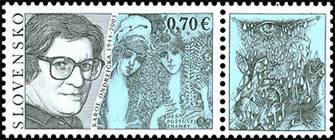
Scott: #608P
Issued: 03.12.2010
Stamp Day
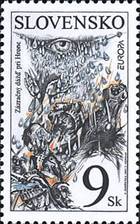 Inside #608 (On label):
Inside #608 (On label):
Lou
Wrote: I looked for the artwork in the stamp on a Slovak stamp but it does not
exist. The artwork is a monotone detail of a watercolor illustration Ondreicka created in 2000 for the book, “Tales From Slavic
Myths”; shown are the pagan graces, Vesna (Spring)
and Zhiva (Summer)—see scan of very weird painting.
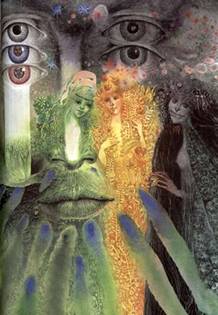
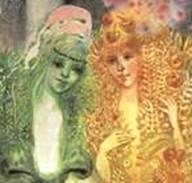
![[Stamp Day - Severín Zrubec, 1921–2011, type YG]](Slovakia_image061.jpg)
Scott: #????O
Issued: 05.12.2014
Stamp Day - Severín Zrubec, 1921–2011
Inside #????: Pseudo stamps
![[Stamp Day - Jozef Vlček, 1902-1971, type AAZ]](Slovakia_image062.jpg)
Scott: #???P
Issued: 04.12.2017
Stamp Day
![[Delivery Stamps, type X]](Slovakia_image063.jpg)
![[Delivery Stamps, type X1]](Slovakia_image064.jpg) Inside #??? (On
label): Slovakia #EX1-2O
Inside #??? (On
label): Slovakia #EX1-2O
![[Stamp Day, type ABZ]](Slovakia_image065.jpg)
Scott: #????O
Issued: 03.12.2018
Stamp Day
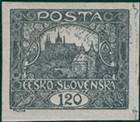 Inside #????:
Czechoslovakia Type A2P,
1919 (Pic of #36)
Inside #????:
Czechoslovakia Type A2P,
1919 (Pic of #36)
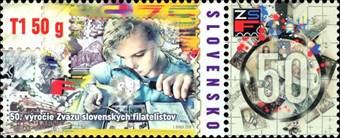
Scott: #????P
Issued: 17.05.2019
the
50th Anniversary of the Slovak Philatelist Society
Inside #????: Pseudo stamps
Inside #???? (On label):
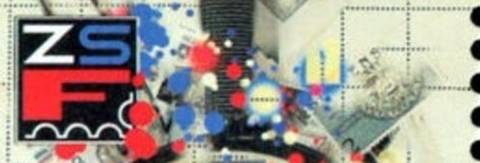
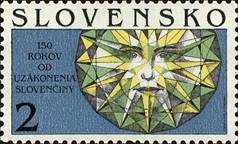

|
|
|
|
|
Slovakia #711P |
Slovakia #609O |
|
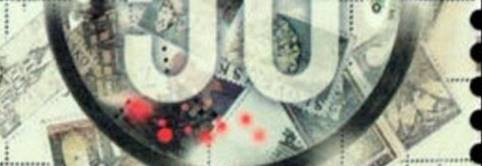
|
|
|
|
|
Slovakia #521P |
Slovakia #600P |
|

|
|
|
|
|
|
Thanks to Lou Guadagno
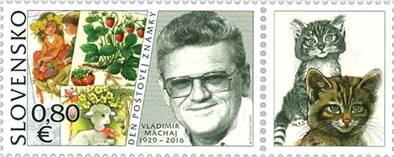
Scott: #????P
Issued: 04.12.2020
Postage Stamp Day honoring Slovak stamp designer, Vladimir Machaj
Inside #???? and on the label, design components of the central motifs
of
4 of Machaj works with all inscriptions and values
omitted
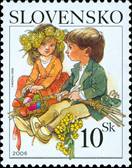 Inside #????:
Slovakia #496P
Inside #????:
Slovakia #496P
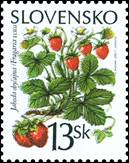 Inside #????:
Slovakia #363bP
Inside #????:
Slovakia #363bP
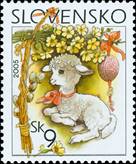 Inside #????:
Slovakia #474P
Inside #????:
Slovakia #474P
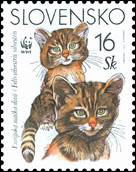 Inside #????:
Slovakia #434cO
Inside #????:
Slovakia #434cO
Lou wrote: Two Machaj
designs for his 2003 WWF issue were included in the Central African Republic
Fauna on Stamps-S Countries omnibus issued on June 22, 2020 which show the
complete stamps.
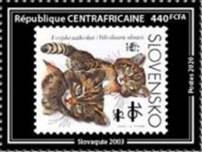
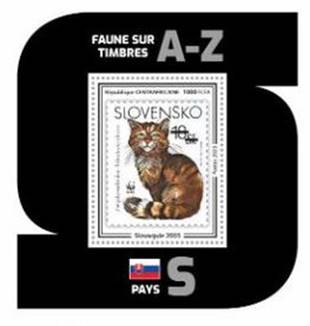
Thanks to Lou Guadagno
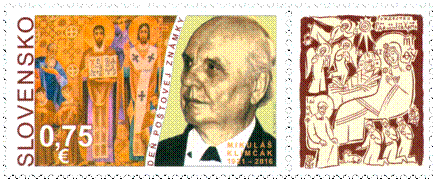
Scott: #????O
Issued: 03.12.2021
Stamp Day
![[Christmas 1997 - The Birth, type HG]](Slovakia_image112.jpg) Inside #???? (On label): Slovakia #288P
Inside #???? (On label): Slovakia #288P
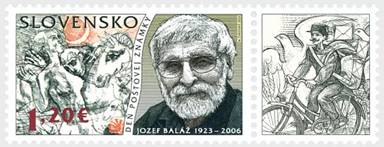
Scott: #????O
Issued: 5.12.2023
Stamp Day
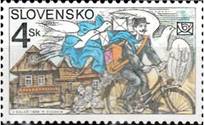 Inside #???? (On
label): Slovakia #318O
Inside #???? (On
label): Slovakia #318O
About
Postage Stamp Day - Jozef Balaz
(1923–2006)
Jozef Baláž
(1923 – 2006) was a painter, graphic artist, illustrator and the doyen and
founder of Slovak postage stamp design. Baláž
made his debut in postage stamp design in 1957. In addition to his free graphic
and illustrative works, in the years that followed he was the enthusiastic
creator of a long line of stamps that started with the three TANAP issues.
Overall, Baláž created the graphic design
for almost 150 stamps, initially Czechoslovak, and later Slovak, stamps.
He
is the chief representative of the movement that was able to
fully penetrate the mysteries of stamp graphics. Even as a part of
Czechoslovak stamp design his use of firm dynamic line drawing, that was a
central element of both his compositions and his expression, attracted
attention. His tilt towards the use of free and illustrative graphics to
provide the motif and expressive design for a stamp makes his stamp designs an
expression of modern fine art. From the considerable body of Czevchoslovak stamps designed by Baláž,
let us recall the issues: Slovak Paradise, Archaeological Findings, the 110th Anniversary of the Universal Postal Union, along
with several issues to celebrate the anniversaries of the Slovak National
Uprising as well as a portrait of a smiling Gagarin and of Andrej Hlinka, which received a national prize. In
addition to his drawing on the gutter of the printing sheet of the first Slovak
stamp to be issued: the Slovak State Symbol, we should also mention his work in
the design of Slovak stamps for the first years of various issues; for example,
the 50th Anniversary of the Slovak National Uprising, the 5th Anniversary of
the Constitution, the Černová issue, and
multiple stamps that bear the portraits of historical figures and events.
His
fictitious portraits of Great Moravian figures, for example, Pribina, Rastislav, Koceľ and Svätopluk are
especially valuable. The French-Slovak issue: M. R. Štefánik
from 2003 is also worthy of mention. His stamp, Ľudovít
Štúr, designed as a double portrait
including the personification of Štúr’s
muse – the Slovak language, provides the most innovative solution from among
his portrait stamps. Multiple issues were awarded
prizes by numerous philatelic polls and assessments of professional juries.
Certainly, the award received at the Grand Prix de lʼexposition
WIPA1996 is an exceptionally valuable example. The Ľudovít
Štúr issue received the first and most
precious international award for Slovak stamp design. Apart from the creative
input of Baláž, the stamp was also shaped by his participation in the proceedings of
the consultative bodies of the issuer. He was the first chairman
of the Postage Stamp Design Commission.
In
2001, Jozef Baláž
was awarded the state decoration, the 2nd Class Order
of Ľudovít Štúr,
for his exceptional contribution to Slovak stamp design graphics. May the issue
of this postage stamp be a suitable tribute to an artist who spent half a
century shaping the design of postage stamps in a unique way.
Thanks to Martin Hirschbühl
Best website related:
![]()
Wish
List
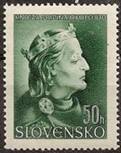
Slovakia #95
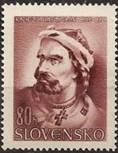
Slovakia #98
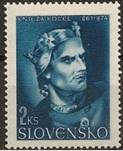
Slovakia #99

Slovakia #100
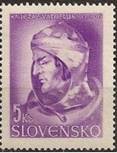
Slovakia #101
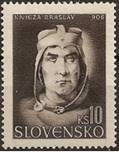
Slovakia #102
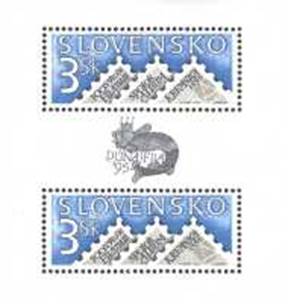
Slovakia #217a
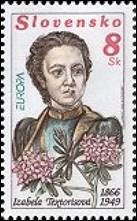
Slovakia #244 for Netherlands
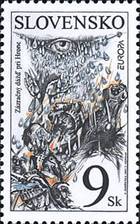
Slovakia #270
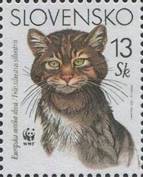
Slovakia #434a for Liberia, Djibouti

Slovakia #434b for Chad, Djibouti
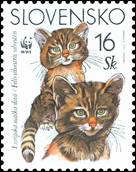
Slovakia #434c + Central African Republic, Liberia, Sierra
Leone
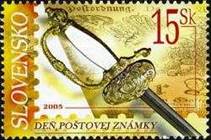
Slovakia #491
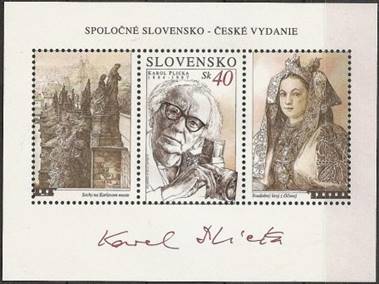
Slovakia #548
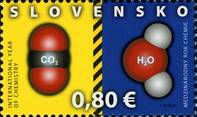
Slovakia #609
![[Stamp Day - Severín Zrubec, 1921–2011, type YG]](Slovakia_image061.jpg)
Scott: #???? 2014
![[Stamp Day, type ABZ]](Slovakia_image065.jpg)
Scott: #???? 2018
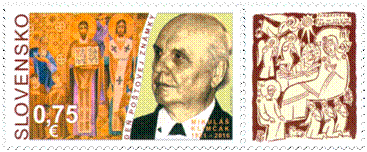
Slovakia #????
![[The 32nd Summer Olympic Games - Tokyo, Japan, type AEJ]](Slovakia_image144.jpg)
Slovakia
#874 (2021) for Chad, Djibouti
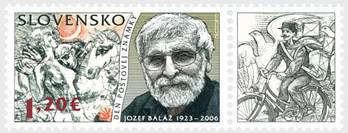
Slovakia #????


